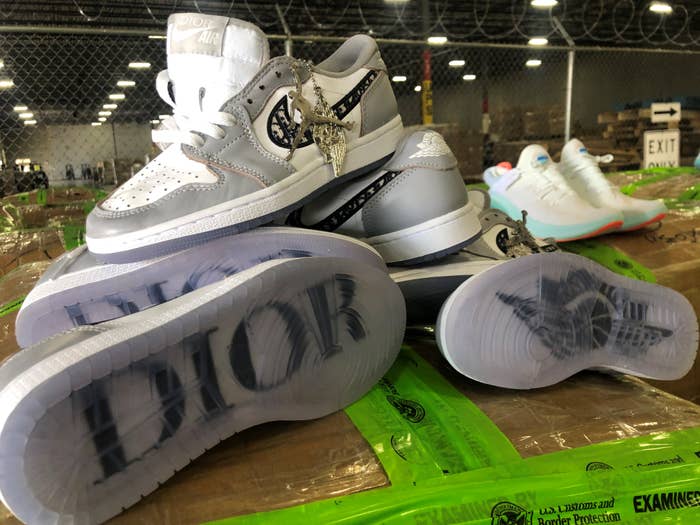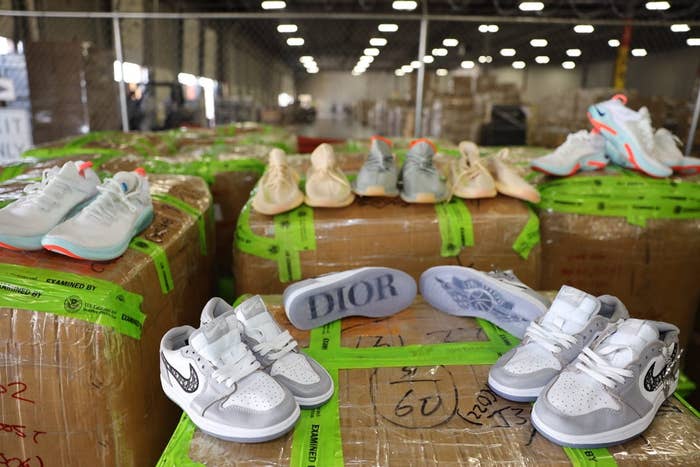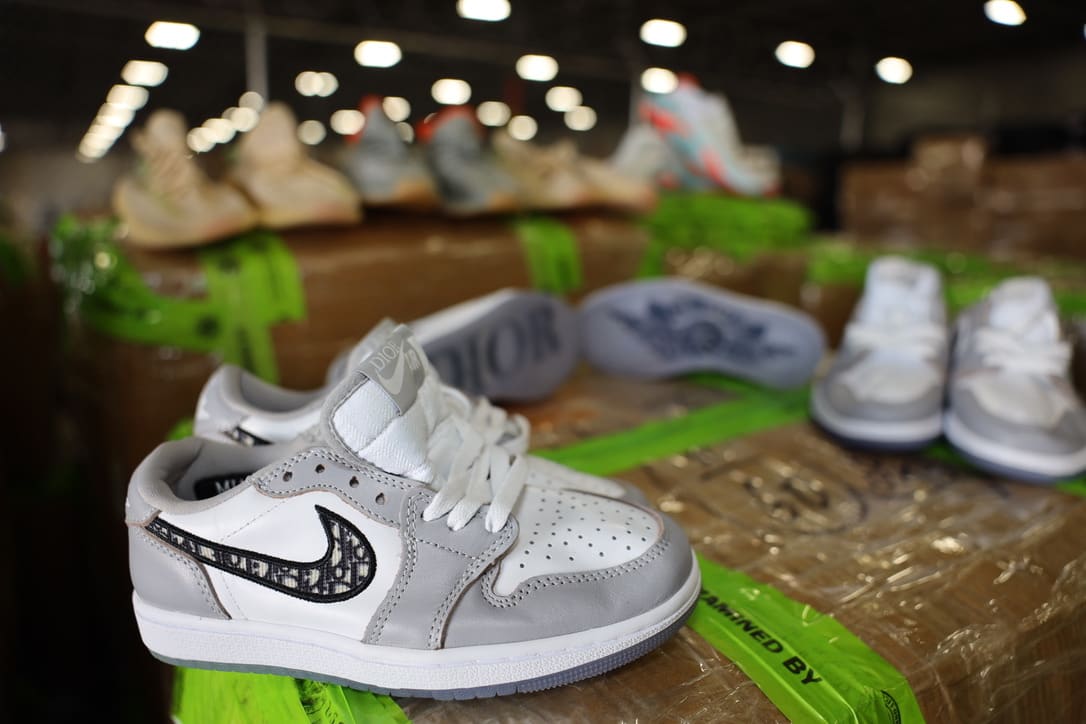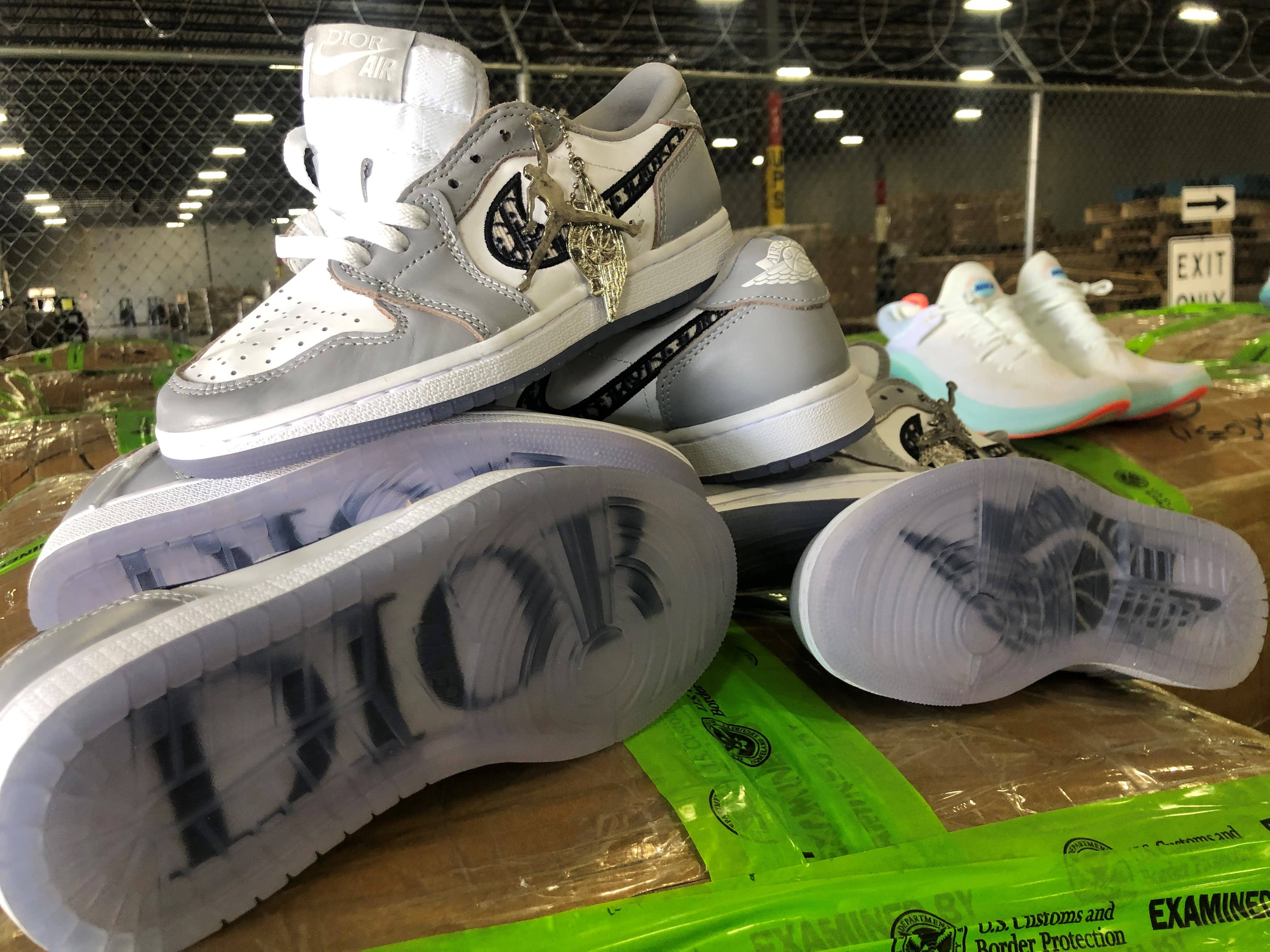
This is where counterfeit sneakers go to die. This is limbo, a waiting phase organized by the Department of Homeland Security. Here, fraudulent footwear takes its final steps, tumbling into a shredder that will chew whole pairs into cornflake-size bits. I can't tell you exactly where the purgatory is—because the government won't tell me—but imagine a nondescript warehouse somewhere in Texas that reeks of the pernicious, oily odor of fake shoes. Currently among the doomed and waiting are 1,800 pairs of knockoff Dior x Air Jordan 1 Low sneakers seized by Customs and Border Protection at the Dallas-Fort Worth port of entry in a July 17 bust.
They were supposed to be golf balls, 3,000 kilograms' worth. At least, that's what the shipping documents said. They were supposed to make their way from Hong Kong to Mexico. Instead, they got jammed up in Texas, where CBP officers inspected the shipment and discovered that the 60 boxes were stuffed with fake Dior x Air Jordans and Adidas Yeezys. Valuing the high-end Jordans at their $2,000-per-pair retail price, the agency put the worth of the fraudulent goods at over $4.3 million in total.
Their aim now is to render them valueless, hence the shredder. Soon, seized property contractors will destroy the shoes. Somewhere in Texas, a death rattle will yelp from the clanging machinery while a confetti of synthetic leather decorates the air.
What red flags sealed their fate? How adept is the government at discerning counterfeit shoes from real ones? For answers, I turned to Raul Orona, chief CBP officer of import and export in Dallas-Fort Worth, who was gracious enough to field these questions despite me mistakenly calling him "Officer Corona" at the beginning of our conversation. The conversation, lightly edited for length, appears below.
What happens to sneakers after a big bust like this?
We go through a seizure process where all the parties are notified and they're given the chance to plead on whether they believe their shipment was legitimate or not. And then, through due process, if it's found out that they don't have the right to have these sneakers, or to import them, or to pass them through, or to obtain them, then they're destroyed.
How exactly are they destroyed? Is there a wood chipper you throw them in? Are you having a bonfire?
They're usually shredded up into cornflakes. There's different methods.
You said into cornflakes?
Well, that's…that's a pun. They're mutilated. Let's put it that way.

I read in the press release that the Department of Homeland Security seized around $37 million worth of counterfeit footwear in 2019. All of that is destroyed?
Yes, sir.
Do the brands ever want to keep it for some sort of evidence?
There are times where, yes, they will take samples of some of the counterfeit products for trainings and they retain. They request permission from us. But yes, there are times when we do turn over some of the samples, over to the brand.
And do you have experts to consult with on your team who know what a fake sneaker looks like?
Oh, yes. Our officers are given training. We have representatives from the major footwear designers that provide training to our officers and to our import specialists. That show us—that show all the officers what to look for compared to what they've encountered with counterfeit goods, and what the legitimate product looks like.
They go to a sort of sneaker school to figure this stuff out?
Well, it's usually in-house training. They'll come to us. They'll come to our office, they'll provide a sample of the counterfeit shoes and also what legitimate shoes look like.

Do you know personally some of the details that reveal a shoe to be counterfeit?
They go into some secret things that they put into their shoes. They're pretty much like trade secrets where we can't disclose the things that they share with us as manufacturers, but one of the telltales is that most of the counterfeit shoes smell like glue. You can smell the overpowering glue that's used. You don't smell the legitimate, genuine leather most shoes are made out of.
Yeah, it's a beautiful smell to people like me. So you're saying that there are some industry trade secrets in terms of stuff the brands put inside shoes that confirm them as authentic?
Yes, sir. Some of the major footwear [companies], yes, they embed some type of coding and things within the shoe that they've indicated to us to look for.
Are we talking about RFID chips?
No. No, not that. Not that specific, no.
Do you have any idea how much these counterfeit Jordans in particular would be sold for in Mexico?
No, I'm not sure how much they would go for in Mexico.

The retail on these is $2,000, and you can resell them for $10,000, but I just don't know how much of a hard time you'd have getting anybody to pay $2,000 for these, given how clearly they are a counterfeit, you know?
Exactly. I think now, with the way sales are throughout the world, I could possibly see somebody just opening up a shop in Mexico and shipping them out worldwide, if they had the business to do that.
How soon did you realize something was awry with this shipment?
Our officers are highly trained and experienced in identifying suspicious cargo shipments. In this particular shipment, it was the weight. It was 3,000-plus kilograms of golf balls going to a suspicious address in Mexico. So that kind of raised some flags. You would tend to see golf balls going to a major golf ball manufacturer or something, if it was actually golf balls. But that kind of raised some suspicion, so we ended up placing the shipment on hold and then going out there and looking at it. That's when we revealed that it was the counterfeit footwear.
How often do you see these counterfeit sneakers come through like this?
We usually see them, like, at a pair or two come through, or even, I think prior to this larger seizure that we had, we had a couple of hundred pairs. But 3,000 kilograms of shoes was definitely eye-opening. Don't see it that often, let's put it that way. Not since probably about a decade, when e-commerce pushed up.
Have you seen how much they go for on the resell market?
So, from what I get, there's a lottery, a lottery just to purchase one, right? So you get that purchase, you purchased it, and then I guess they can go anywhere up to $10,000?
Yeah.
The sale price is 3,000, right? Two to 3,000. But now, if you get it and you auction it off, or if you go to these platforms to resell, I think they've gone for 10,000.
But you will not be auctioning them off.
No. It'd be a good way to pay off the deficit, right? No. The main thing, why we destroy them, is because of the way they're made. They're not up to par. So if we were going to go to some donation program and give them out to individuals, we're putting their health and their safety at risk. I wouldn't run around in any of these shoes—put it that way.
Do you ever donate shoes?
No.
Because they're fake.
Because they're not made to specifications, the quality assurance from the legitimate manufacturers.
Plus the smell.
Yeah, plus the smell.

